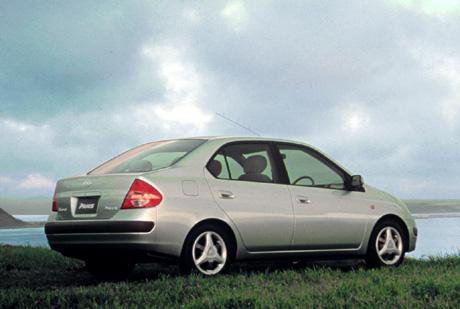

In Latin, "prius" means "before." In the automotive world, the Toyota Prius is definitely before its time.
Developed for (and available in) the Japanese market only
- where it goes on sale this December -- the Prius Hybrid Passenger Vehicle utilizes both a gasoline engine and an electric motor as motive power sources. The Prius emits less pollution than ordinary cars, and it gets more mileage, which means less output of carbon dioxide. Moreover, the Prius provides highly responsive performance and smooth acceleration. With its futuristic packaging and design, the Prius offers comfortable cabin space and a high level of active and passive safety features, thus epitomizing all that a twenty-first century car should and will be.
Better Than Hybrid
"Hybrid cars outperform pure-electric vehicles in charging
time, driving range, and cost," asserts Toyota's Dr.
Takehisa Yaegashi. "They outperform conventional vehicles in
terms of improving fuel economy and reducing emissions."
But Toyota's new car is more than just a hybrid. Much more. It is a hybrid of hybrids. Some hybrid systems use their engine just to generate electricity for charging the batteries to run the electric motor. Others use the engine and motor alternately, depending on the driving conditions. The Prius combines the best of both systems. It uses a continuously variable combination of gasoline and electric power to help maximize energy efficiency and minimize emissions.
"We start our vehicle up on battery power," explains Yaegashi. "When the car gets up to speed, it runs on a combination of gasoline and electric power."
A computerized power splitter directs power from the engine to the wheels and also to the generator. It keeps the engine running in an efficient range. During acceleration the supplemental power from the motor reduces the load on the engine. The car runs on electric power alone under light loads, as on downgrades.
Toyota's system diverts output from the generator to recharge the batteries whenever they are low. And a regenerative braking system recovers energy from the wheels during downhill driving and braking and uses it to generate electricity. No other charging is ever necessary for the batteries.
"The changeover between gasoline and electric power is so smooth that drivers don't even notice," reports Yaegashi. "You need to look at the power-flow meter on the dashboard to see what's happening."
What's Next
Costs will need to come down for Toyota's hybrid to be
competitive around the world, where gasoline prices are lower
than in Japan. Economies of scale will help as production volumes
increase. But further advances in engineering also will be
essential. "We've got our work cut out for us,"
concedes Yaegashi. "But I never thought we'd get this far
this fast. This technology has made a believer out of me."
